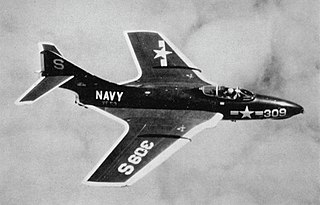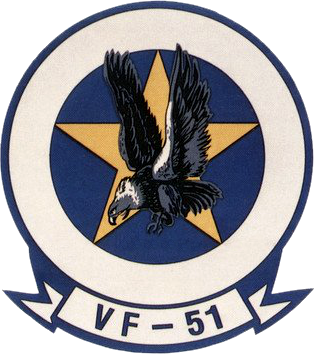
The Grumman F11F/F-11 Tiger is a supersonic, single-seat carrier-based fighter aircraft designed and produced by the American aircraft manufacturer Grumman. For a time, it held the world altitude record of 76,939 feet (23,451 m), as well as being the first supersonic fighter to be produced by Grumman.

The Grumman F9F/F-9 Cougar is a carrier-based jet-powered fighter aircraft designed and produced by the American aircraft manufacturer Grumman.

Strike Fighter Squadron 211 (VFA-211), nicknamed the "Fighting Checkmates", is an aviation unit of the United States Navy established in 1945. The squadron is based at Naval Air Station Oceana and is equipped with the Boeing F/A-18E Super Hornet.

Strike Fighter Squadron 103 (VFA-103), nicknamed the Jolly Rogers, is an aviation unit of the United States Navy established in 1952. VFA-103 flies the F/A-18F Super Hornet and is based at Naval Air Station Oceana, Virginia (US). The squadron's radio callsign is Victory and it is assigned to Carrier Air Wing Seven.

A carrier air wing is an operational naval aviation organization composed of several aircraft squadrons and detachments of various types of fixed-wing and rotary-wing aircraft. Organized, equipped and trained to conduct modern US Navy carrier air operations while embarked aboard aircraft carriers, the various squadrons in an air wing have different but complementary missions, and provide most of the striking power and electronic warfare capabilities of a carrier battle group (CVBG). While the CVBG term is still used by other nations, the CVBG in US parlance is now known as a carrier strike group (CSG).

VF-51, Fighter Squadron 51 was an aviation unit of the United States Navy known as the "Screaming Eagles". It was originally established as VF-1 on 1 February 1943, redesignated as VF-5 on 15 July 1943, redesignated as VF-5A on 15 November 1946, redesignated VF-51 on 16 August 1948, and disestablished in March 1995. Until its disestablishment, VF-51 was the oldest fighter squadron in continuous service with the Pacific Fleet.

Fighter Squadron 111 (VF-111), also known as the Sundowners, was a fighter squadron of the United States Navy. Originally established as Fighter Squadron 11 (VF-11) on 10 October 1942, it was redesignated as VF-11A on 15 November 1946, redesignated as VF-111 on 15 July 1948 and disestablished on 19 January 1959. On 20 January, another squadron, VF-111 (1956-95) then assumed the designation until its de-establishment in 1995. In November 2006, VFC-13 Detachment Key West was redesignated as VFC-111, taking on the Sundowner insignia and callsign.

Fighter Squadron 114 (VF-114) was a fighter squadron of the United States Navy that was active from 1945 through 1993. Nicknamed the "Aardvarks", it was based out of Naval Air Station Miramar, California. The squadron flew combat missions during the Korean War and Vietnam War. VF-114 was disestablished as part of the post-Cold War drawdown of forces on 30 April 1993.

Fighter Squadron 124 or VF-124Gunfighters was a fleet replacement squadron (FRS) of the United States Navy. Originally established on 16 August 1948 as VF-53, it was redesignated VF-124 at NAS Moffett Field on 11 April 1958 due to a need for an increased number of flight training squadrons, itself necessary because of introduction of swept wing fighters into Navy service. In 1961, the squadron relocated to NAS Miramar, California, which would become the U.S. Pacific Fleet's Master Jet Base for fighter aircraft.

Strike Fighter Squadron 143 (VFA-143), also known as the "Pukin Dogs," is a United States Navy strike fighter squadron based at Naval Air Station Oceana, Virginia. The Pukin Dogs are an operational fleet squadron and flying the F/A-18E Super Hornet. They are currently attached to Carrier Air Wing One and USS Harry S Truman. They are currently at their homeport of NAS Oceana. Their radio callsign is Taproom.

Fighter Squadron 194 (VF-194) was an aviation unit of the United States Navy. It was originally established as VF-91 on 26 March 1952, redesignated VF-194 on 1 August 1963 and disestablished on 1 March 1978. It was the third US Navy squadron to be designated VF-194.

Fighter Squadron 53, or VF-53Iron Angels was an aviation unit of the United States Navy in service from 20 July 1950 to 29 January 1971. Originally established as reserve squadron VF-721 on 20 July 1950, it was redesignated as VF-141 on 4 February 1953 and then redesignated as VF-53 on 15 October 1963. The squadron was disestablished on 29 January 1971. It was the fourth US Navy squadron to be designated as VF-53.

Robert L. "Bob" Rasmussen, is a noted military artist; a retired Captain of the United States Navy; a former career naval aviator, primarily in the F-8 Crusader; a former member of the U.S. Navy Flight Demonstration Squadron, the Blue Angels, and former Director of the National Naval Aviation Museum at NAS Pensacola, Florida.

The North American FJ-1 Fury was an early turbojet-powered carrier-capable fighter aircraft used by the United States Navy (USN). Developed by North American Aviation (NAA) starting in 1945, it became the first jet aircraft in USN service to serve at sea under operational conditions. This first version of the FJ was a straight-winged jet, briefly operational during the transition to more successful designs. An evolution of the FJ-1 would become the land-based XP-86 prototype of the United States Air Force's enormously influential F-86 Sabre, which in turn formed the basis for the Navy's carrier-based, swept-winged North American FJ-2/-3 Fury.

Fighter Squadron 96, or VF-96Fighting Falcons was an aviation unit of the United States Navy in service from 1962 to 1975. When assigned to Carrier Air Wing Nine (CVW-9) their tailcode was NG, and their radio callsign was Showtime. Originally established as United States Naval Reserve squadron VF-791Fighting Falcons on 20 July 1950 it was redesignated VF-142 after becoming a regular squadron on 4 February 1953. It was re-designated VF-96 on 1 June 1962 and disestablished on 1 December 1975.
Fighter Squadron 122 or VF-122 was an aviation unit of the United States Navy. Originally established as Reserve Squadron 783 (VF-783) it was called to active duty on 2 August 1950, it was re-designated VF-122 on 4 February 1953 and disestablished on 10 April 1958.

Fighter Squadron 173 or VF-173 was an aviation unit of the United States Navy established on 11 August 1948 and disestablished on 1 February 1959.

Fighter Squadron 111 (VF-111), also known as the Sundowners, was a fighter squadron of the United States Navy. Originally established as Attack Squadron 156 (VA-156) on 4 June 1955, it was redesignated VF-111 on 20 January 1959, the day after the original VF-111 was disestablished. The squadron was redesignated VF-26 on 1 September 1964, redesignated as VF-111 on 17 September 1964 and disestablished on 31 March 1995.
In 1989, the United States Navy was on the verge of massive cuts to military spending cuts including ship and aircraft procurement. These forces were expected to fight the Soviet Union, Warsaw Pact and other potential adversaries in case of a war breaking out. At this time, the USS Kitty Hawk (CV-63) of the Pacific Fleet was out of commission for Service Life Extension Program (SLEP) modernization leaving the 3rd Fleet with less carriers.





















